Abstract
Production of cytotoxin and enterotoxin by Aeromonas strains obtained from stools of 50 children in Mexico and Texas and from blood of 9 children with sepsis was determined. Results were correlated with clinical features of infected children as well as with biochemical traits of Aeromonas strains. Cytotoxin was produced by 40 of 42 Aeromonas strains (95%) isolated from stools of children with diarrhea, by all 8 isolates from stools of well children, and by all 9 isolates from children with sepsis. There was no difference in the quantities (amount of cytotoxin per milligram of protein required to kill 50% of the cells) of cytotoxin produced and in clinical manifestations among the groups. None of the isolates produced a toxin that could be neutralized by antiserum raised against Shiga toxin produced by Shigella dysenteriae 1 60R. Heat-labile-like enterotoxin (LT) was produced by 26 of 42 stool isolates (62%), while only 1 of the 42 isolates (2%) produced enterotoxinlike activity in suckling mice; 65% of the cytotoxin-producing strains also produced an LT-like material. All strains from blood produced LT-like material, and 2 of 6 (33%) produced activity in suckling mice. All strains produced hemolysin; 37 of 57 (65%) were Voges-Proskauer positive; 27 of 57 (47%) were lysine decarboxylase positive by API 20E strips, none were positive for lysine decarboxylose production by lysin-iron agar slants at 24 h, but 17 of 54 (31%) were positive at 48 h. There was no correlation between biochemical reactions and enterotoxin or cytotoxin production. There appears to be no correlation between toxin production by Aeromonas spp. and gastroenteritis.
Full text
PDF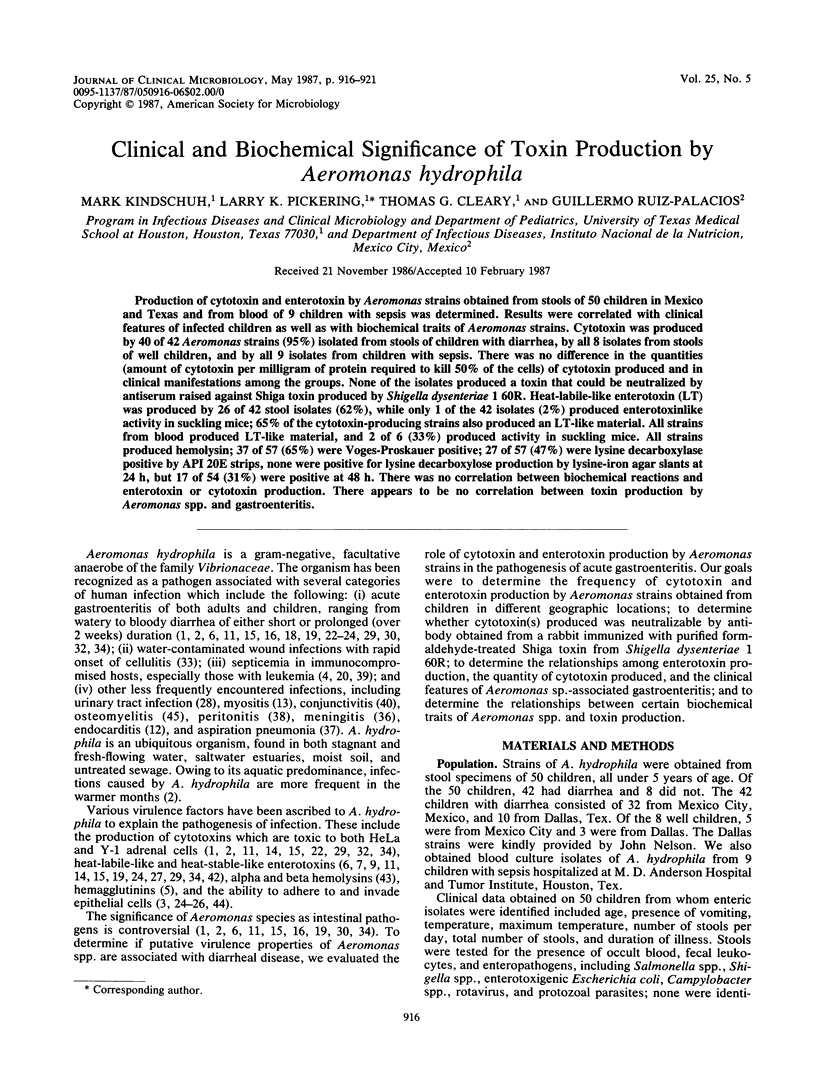

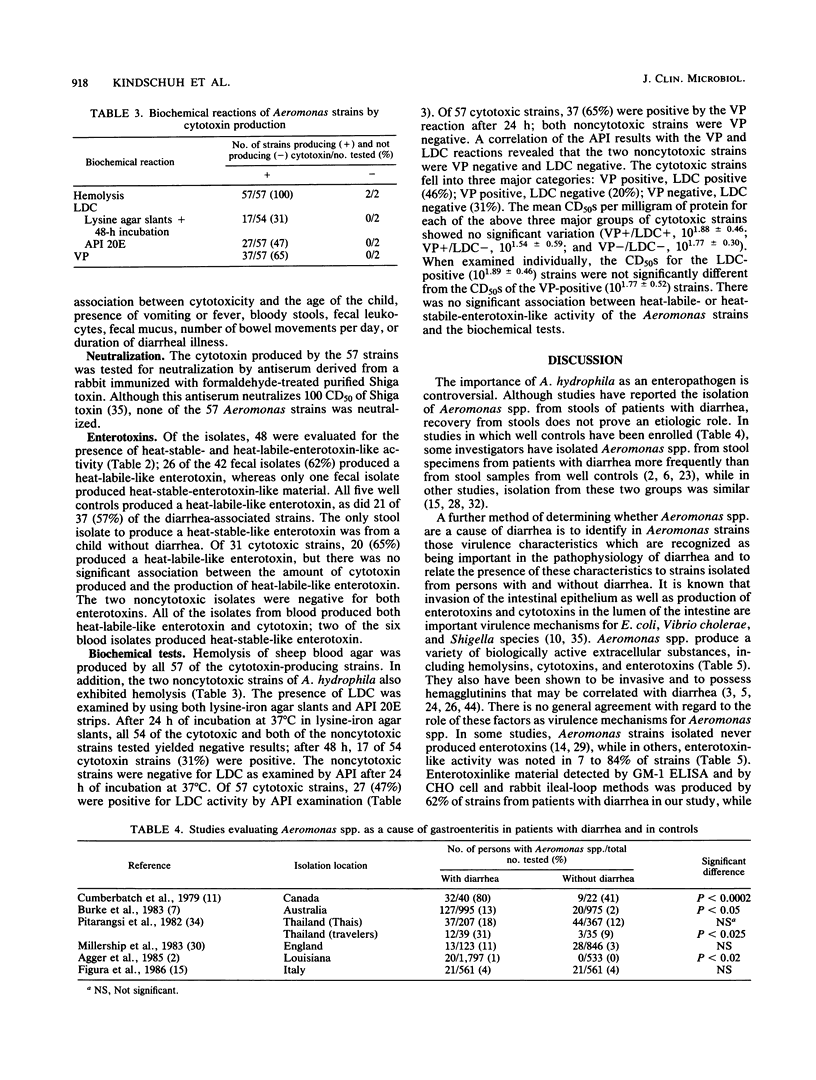
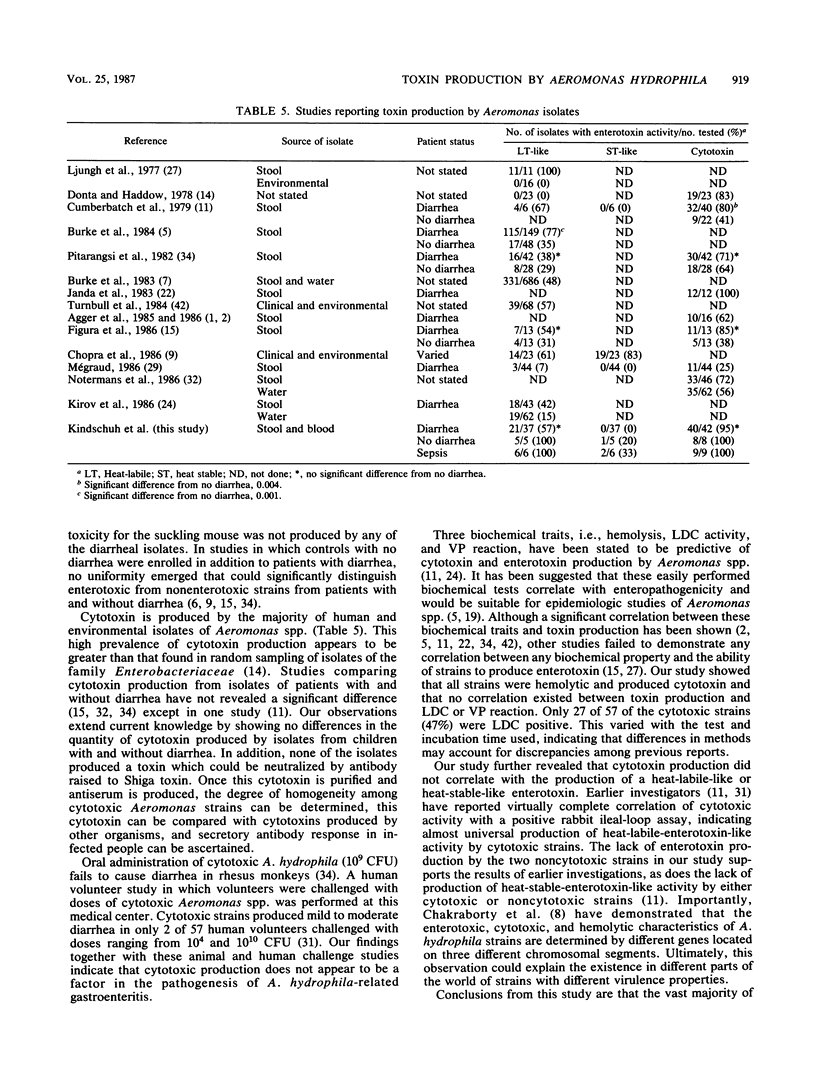
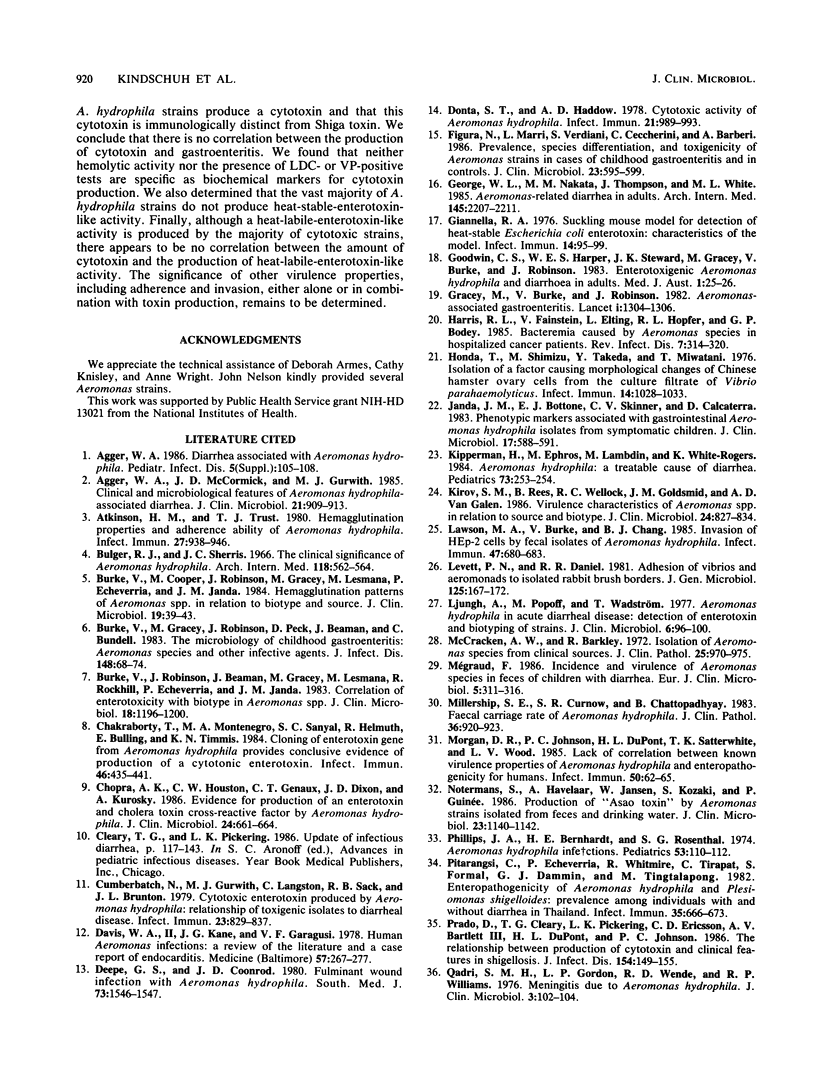
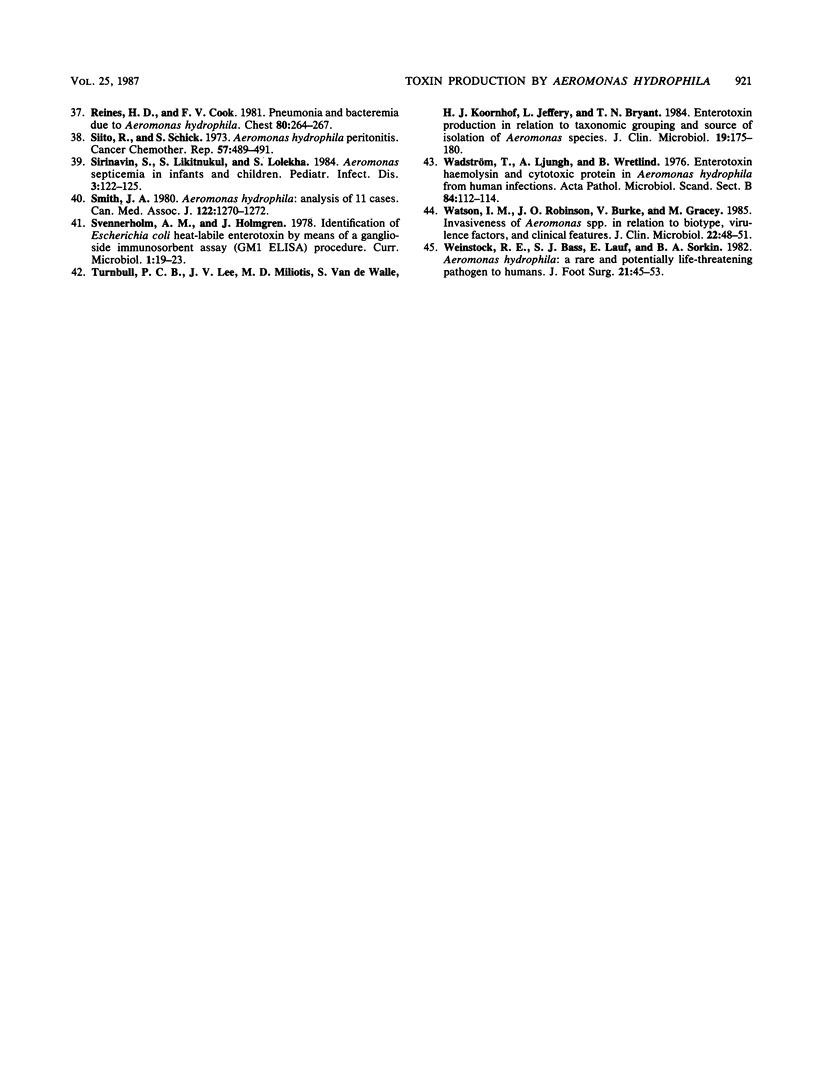
Selected References
These references are in PubMed. This may not be the complete list of references from this article.
- Agger W. A., McCormick J. D., Gurwith M. J. Clinical and microbiological features of Aeromonas hydrophila-associated diarrhea. J Clin Microbiol. 1985 Jun;21(6):909–913. doi: 10.1128/jcm.21.6.909-913.1985. [DOI] [PMC free article] [PubMed] [Google Scholar]
- Atkinson H. M., Trust T. J. Hemagglutination properties and adherence ability of Aeromonas hydrophila. Infect Immun. 1980 Mar;27(3):938–946. doi: 10.1128/iai.27.3.938-946.1980. [DOI] [PMC free article] [PubMed] [Google Scholar]
- Bulger R. J., Sherris J. C. The clinical significance of Aeromonas hydrophila. Report of two cases. Arch Intern Med. 1966 Dec;118(6):562–564. [PubMed] [Google Scholar]
- Burke V., Cooper M., Robinson J., Gracey M., Lesmana M., Echeverria P., Janda J. M. Hemagglutination patterns of Aeromonas spp. in relation to biotype and source. J Clin Microbiol. 1984 Jan;19(1):39–43. doi: 10.1128/jcm.19.1.39-43.1984. [DOI] [PMC free article] [PubMed] [Google Scholar]
- Burke V., Gracey M., Robinson J., Peck D., Beaman J., Bundell C. The microbiology of childhood gastroenteritis: Aeromonas species and other infective agents. J Infect Dis. 1983 Jul;148(1):68–74. doi: 10.1093/infdis/148.1.68. [DOI] [PubMed] [Google Scholar]
- Burke V., Robinson J., Beaman J., Gracey M., Lesmana M., Rockhill R., Echeverria P., Janda J. M. Correlation of enterotoxicity with biotype in Aeromonas spp. J Clin Microbiol. 1983 Nov;18(5):1196–1200. doi: 10.1128/jcm.18.5.1196-1200.1983. [DOI] [PMC free article] [PubMed] [Google Scholar]
- Chakraborty T., Montenegro M. A., Sanyal S. C., Helmuth R., Bulling E., Timmis K. N. Cloning of enterotoxin gene from Aeromonas hydrophila provides conclusive evidence of production of a cytotonic enterotoxin. Infect Immun. 1984 Nov;46(2):435–441. doi: 10.1128/iai.46.2.435-441.1984. [DOI] [PMC free article] [PubMed] [Google Scholar]
- Chopra A. K., Houston C. W., Genaux C. T., Dixon J. D., Kurosky A. Evidence for production of an enterotoxin and cholera toxin cross-reactive factor by Aeromonas hydrophila. J Clin Microbiol. 1986 Oct;24(4):661–664. doi: 10.1128/jcm.24.4.661-664.1986. [DOI] [PMC free article] [PubMed] [Google Scholar]
- Cleary T. G., Pickering L. K. Update on infectious diarrhea. Adv Pediatr Infect Dis. 1986;1:117–143. [PubMed] [Google Scholar]
- Cumberbatch N., Gurwith M. J., Langston C., Sack R. B., Brunton J. L. Cytotoxic enterotoxin produced by Aeromonas hydrophila: relationship of toxigenic isolates to diarrheal disease. Infect Immun. 1979 Mar;23(3):829–837. doi: 10.1128/iai.23.3.829-837.1979. [DOI] [PMC free article] [PubMed] [Google Scholar]
- Davis W. A., 2nd, Kane J. G., Garagusi V. F. Human aeromonas infections: a review of the literature and a case report of endocarditis. Medicine (Baltimore) 1978 May;57(3):267–277. [PubMed] [Google Scholar]
- Deepe G. S., Jr, Coonrod J. D. Fulminant wound infection with Aeromonas hydrophila. South Med J. 1980 Nov;73(11):1546–1547. doi: 10.1097/00007611-198011000-00042. [DOI] [PubMed] [Google Scholar]
- Donta S. T., Haddow A. D. Cytotoxic activity of Aeromonas hydrophila. Infect Immun. 1978 Sep;21(3):989–993. doi: 10.1128/iai.21.3.989-993.1978. [DOI] [PMC free article] [PubMed] [Google Scholar]
- Figura N., Marri L., Verdiani S., Ceccherini C., Barberi A. Prevalence, species differentiation, and toxigenicity of Aeromonas strains in cases of childhood gastroenteritis and in controls. J Clin Microbiol. 1986 Mar;23(3):595–599. doi: 10.1128/jcm.23.3.595-599.1986. [DOI] [PMC free article] [PubMed] [Google Scholar]
- George W. L., Nakata M. M., Thompson J., White M. L. Aeromonas-related diarrhea in adults. Arch Intern Med. 1985 Dec;145(12):2207–2211. [PubMed] [Google Scholar]
- Giannella R. A. Suckling mouse model for detection of heat-stable Escherichia coli enterotoxin: characteristics of the model. Infect Immun. 1976 Jul;14(1):95–99. doi: 10.1128/iai.14.1.95-99.1976. [DOI] [PMC free article] [PubMed] [Google Scholar]
- Goodwin C. S., Harper W. E., Stewart J. K., Gracey M., Burke V., Robinson J. Enterotoxigenic Aeromonas hydrophila and diarrhoea in adults. Med J Aust. 1983 Jan 8;1(1):25–26. doi: 10.5694/j.1326-5377.1983.tb136018.x. [DOI] [PubMed] [Google Scholar]
- Gracey M., Burke V., Robinson J. Aeromonas-associated gastroenteritis. Lancet. 1982 Dec 11;2(8311):1304–1306. doi: 10.1016/s0140-6736(82)91510-0. [DOI] [PubMed] [Google Scholar]
- Harris R. L., Fainstein V., Elting L., Hopfer R. L., Bodey G. P. Bacteremia caused by Aeromonas species in hospitalized cancer patients. Rev Infect Dis. 1985 May-Jun;7(3):314–320. doi: 10.1093/clinids/7.3.314. [DOI] [PubMed] [Google Scholar]
- Honda T., Shimizu M., Takeda Y., Miwatani T. Isolation of a factor causing morphological changes of chinese hamster ovary cells from the culture filtrate of Vibrio parahaemolyticus. Infect Immun. 1976 Oct;14(4):1028–1033. doi: 10.1128/iai.14.4.1028-1033.1976. [DOI] [PMC free article] [PubMed] [Google Scholar]
- Janda J. M., Bottone E. J., Skinner C. V., Calcaterra D. Phenotypic markers associated with gastrointestinal Aeromonas hydrophila isolates from symptomatic children. J Clin Microbiol. 1983 Apr;17(4):588–591. doi: 10.1128/jcm.17.4.588-591.1983. [DOI] [PMC free article] [PubMed] [Google Scholar]
- Kipperman H., Ephrds M., Lambdin M., White-Rogers K. Aeromonas hydrophila: a treatable cause of diarrhea. Pediatrics. 1984 Feb;73(2):253–254. [PubMed] [Google Scholar]
- Kirov S. M., Rees B., Wellock R. C., Goldsmid J. M., Van Galen A. D. Virulence characteristics of Aeromonas spp. in relation to source and biotype. J Clin Microbiol. 1986 Nov;24(5):827–834. doi: 10.1128/jcm.24.5.827-834.1986. [DOI] [PMC free article] [PubMed] [Google Scholar]
- Lawson M. A., Burke V., Chang B. J. Invasion of HEp-2 cells by fecal isolates of Aeromonas hydrophila. Infect Immun. 1985 Mar;47(3):680–683. doi: 10.1128/iai.47.3.680-683.1985. [DOI] [PMC free article] [PubMed] [Google Scholar]
- Levett P. N., Daniel R. R. Adhesion of vibrios and aeromonads to isolated rabbit brush borders. J Gen Microbiol. 1981 Jul;125(1):167–172. doi: 10.1099/00221287-125-1-167. [DOI] [PubMed] [Google Scholar]
- Ljungh A., Popoff M., Wadstrom T. Aeromonas hydrophila in acute diarrheal disease: detection of enterotoxin and biotyping of strains. J Clin Microbiol. 1977 Aug;6(2):96–100. doi: 10.1128/jcm.6.2.96-100.1977. [DOI] [PMC free article] [PubMed] [Google Scholar]
- McCracken A. W., Barkley R. Isolation of Aeromonas species from clinical sources. J Clin Pathol. 1972 Nov;25(11):970–975. doi: 10.1136/jcp.25.11.970. [DOI] [PMC free article] [PubMed] [Google Scholar]
- Millership S. E., Curnow S. R., Chattopadhyay B. Faecal carriage rate of Aeromonas hydrophila. J Clin Pathol. 1983 Aug;36(8):920–923. doi: 10.1136/jcp.36.8.920. [DOI] [PMC free article] [PubMed] [Google Scholar]
- Morgan D. R., Johnson P. C., DuPont H. L., Satterwhite T. K., Wood L. V. Lack of correlation between known virulence properties of Aeromonas hydrophila and enteropathogenicity for humans. Infect Immun. 1985 Oct;50(1):62–65. doi: 10.1128/iai.50.1.62-65.1985. [DOI] [PMC free article] [PubMed] [Google Scholar]
- Notermans S., Havelaar A., Jansen W., Kozaki S., Guinée P. Production of "Asao toxin" by Aeromonas strains isolated from feces and drinking water. J Clin Microbiol. 1986 Jun;23(6):1140–1142. doi: 10.1128/jcm.23.6.1140-1142.1986. [DOI] [PMC free article] [PubMed] [Google Scholar]
- Phillips J. A., Bernhardt H. E., Rosenthal S. G. Aeromonas hydrophila infections. Pediatrics. 1974 Jan;53(1):110–112. [PubMed] [Google Scholar]
- Pitarangsi C., Echeverria P., Whitmire R., Tirapat C., Formal S., Dammin G. J., Tingtalapong M. Enteropathogenicity of Aeromonas hydrophila and Plesiomonas shigelloides: prevalence among individuals with and without diarrhea in Thailand. Infect Immun. 1982 Feb;35(2):666–673. doi: 10.1128/iai.35.2.666-673.1982. [DOI] [PMC free article] [PubMed] [Google Scholar]
- Prado D., Cleary T. G., Pickering L. K., Ericsson C. D., Bartlett A. V., 3rd, DuPont H. L., Johnson P. C. The relation between production of cytotoxin and clinical features in shigellosis. J Infect Dis. 1986 Jul;154(1):149–155. doi: 10.1093/infdis/154.1.149. [DOI] [PubMed] [Google Scholar]
- Qadri S. M., Gordon L. P., Wende R. D., Williams R. P. Meningitis due to Aeromonas hydrophila. J Clin Microbiol. 1976 Feb;3(2):102–104. doi: 10.1128/jcm.3.2.102-104.1976. [DOI] [PMC free article] [PubMed] [Google Scholar]
- Reines H. D., Cook F. V. Pneumonia and bacteremia due to Aeromonas hydrophila. Chest. 1981 Sep;80(3):264–267. doi: 10.1378/chest.80.3.264. [DOI] [PubMed] [Google Scholar]
- Reynolds M. A., Hart C. A., Sills J. A., Getty B. Two cases of adenovirus type I pneumonia: diagnosis by direct electron microscopy and culture. Pediatr Infect Dis. 1986 Jan-Feb;5(1):105–107. doi: 10.1097/00006454-198601000-00021. [DOI] [PubMed] [Google Scholar]
- Saito R., Schick S. Aeromonas hydrophila peritonitis. Cancer Chemother Rep. 1973 Nov-Dec;57(4):489–491. [PubMed] [Google Scholar]
- Sirinavin S., Likitnukul S., Lolekha S. Aeromonas septicemia in infants and children. Pediatr Infect Dis. 1984 Mar-Apr;3(2):122–125. doi: 10.1097/00006454-198403000-00008. [DOI] [PubMed] [Google Scholar]
- Smith J. A. Aeromonas hydrophila: analysis of 11 cases. Can Med Assoc J. 1980 Jun 7;122(11):1270–1272. [PMC free article] [PubMed] [Google Scholar]
- Turnbull P. C., Lee J. V., Miliotis M. D., Van de Walle S., Koornhof H. J., Jeffery L., Bryant T. N. Enterotoxin production in relation to taxonomic grouping and source of isolation of Aeromonas species. J Clin Microbiol. 1984 Feb;19(2):175–180. doi: 10.1128/jcm.19.2.175-180.1984. [DOI] [PMC free article] [PubMed] [Google Scholar]
- Wadström T., Ljungh A., Wretlind B. Enterotoxin, haemolysin and cytotoxic protein in Aeromonas hydrophila from human infections. Acta Pathol Microbiol Scand B. 1976 Apr;84(2):112–114. doi: 10.1111/j.1699-0463.1976.tb01911.x. [DOI] [PubMed] [Google Scholar]
- Watson I. M., Robinson J. O., Burke V., Gracey M. Invasiveness of Aeromonas spp. in relation to biotype, virulence factors, and clinical features. J Clin Microbiol. 1985 Jul;22(1):48–51. doi: 10.1128/jcm.22.1.48-51.1985. [DOI] [PMC free article] [PubMed] [Google Scholar]
- Weinstock R. E., Bass S. J., Lauf E., Sorkin B. A. Aeromonas hydrophilia: a rare and potentially life-threatening pathogen to humans. J Foot Surg. 1982 Spring;21(1):45–53. [PubMed] [Google Scholar]


